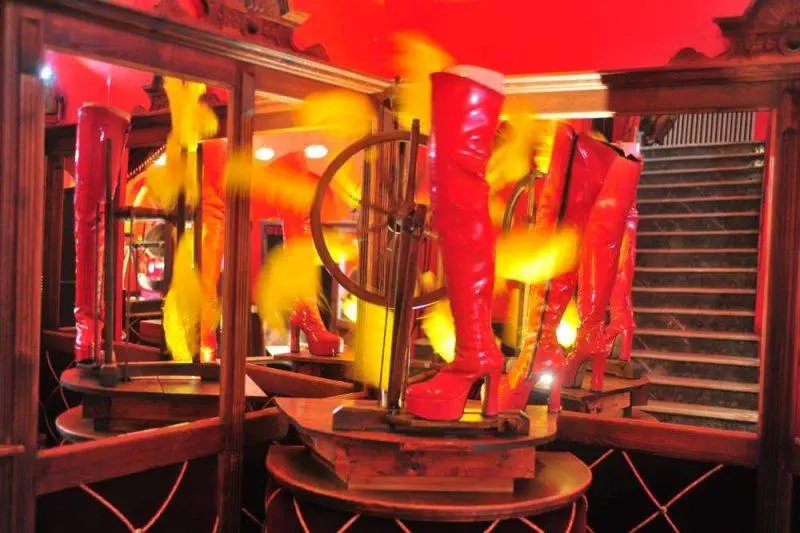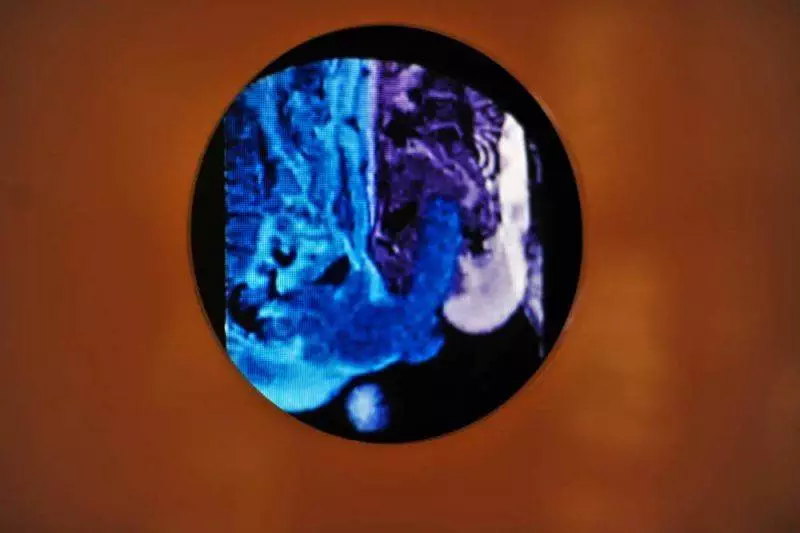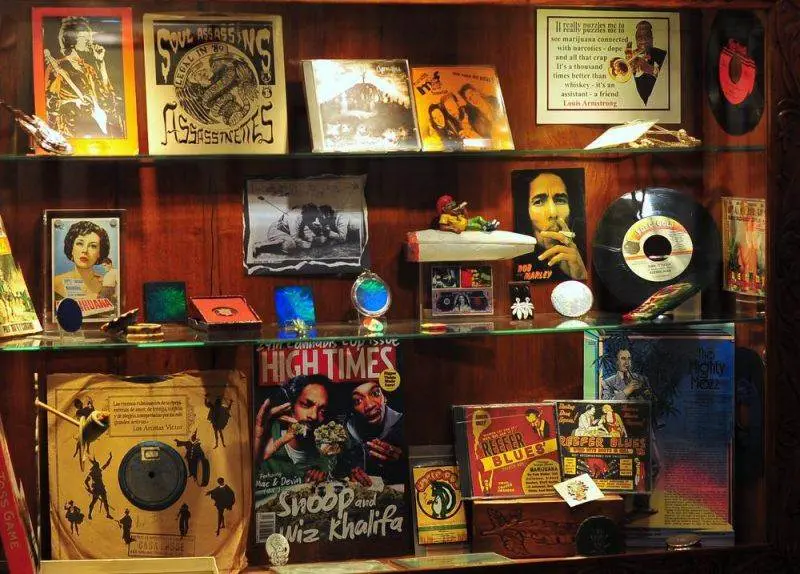Table of Contents
No kids? Great. They’re off traveling on their own? Even better. Presenting some of Europe’s best attractions for the 18-and-up crowd.
Sex Machines Museum — Prague, Czech Republic / Czechia

Let’s kick things off with one of the raunchier places — seriously, if you’re not blushing at least a little at some part of this museum, you’re doing better than I did. Three floors of museum covers a breathtaking array of machines, tools, equipment, clothes, and accessories in the world of sex. Some items date back over a century, and though the forms have certainly changed, the functions haven’t. See my more detailed post about the museum.
Address: Melantrichova 18, 110 00 Praha 1, Prague, Czechia
Admission: 250 Kc
More info: http://www.sexmachinemuseum.com
Museum of Contraception (Museum fur verhutung und Schwangerschaftsabbruch) — Vienna, Austria

While not as raunchy, the Museum of Contraception ends up being a more scientific / clinical look at preventing babies. It’s small, but packed — follow along with the slightly sarcastic narrator on the audioguide to get the details on the sturgeon condom and fish bladder, along with how a sheep appendix was used as a barrier. You’ll also learn why you have Goodyear to thank, if you’re a condom wearer… The museum also follows the legalization of abortion around the world, along with a frank look at the history of IUD’s.
It might feel more like stepping into a doctor’s office than a museum, and you may well be the only ones there. It’s an entertaining, educational place that’s worth taking in with your partner.
Address: Mariahilfer Gurtel 37 A-1150 Wien
Admission: 8 € (6 € w/Vienna card)
More info: en.muvs.org
Giger Museum AKA HR Giger Museum — Gruyeres, Switzerland

If the Alien movies gave you bad dreams, this place has the capacity to bring nightmares. H.R. Giger (1940–2014) is the Swiss artist most famous for the surreal world of the Alien movies and Ridley Scott. No photos allowed inside, but the entrance has plenty to take in as well.
Pay attention to the floor for a schematic pattern of the ship. Paintings / drawings are here from late 1960’s up through the late 1970’s. There’s also concept art, full-scale horrifying face and 2 ½ meter tall alien. While kids are officially allowed inside, an adults-only section shows off the risque side of a twisted mind — double dildoes, tongues replacing nipples, sketch drawings of bondage, metal face and sharp nipples and a strap-on.
It’s not just about Alien, though you’ll see the same themes in large pieces some 2.5 meters square. Look for the tarot of the underworld, the draft sketches, and the piece de resistance — a dining room table with skulls in each corner, skulls stacked on the head chairs and pelvises on top of spines. Don’t forget to take in the bar across the side street!
Address: Château St. Germain, 1663 Gruyères, Switzerland
Admission: 12.50 CHF
More info: www.hrgigermuseum.com
Erotica Museum (Museu de l’Erotica) — Barcelona, Spain

Don’t let the name fool you. With a broad variety of offerings related to kinky times, there’s plenty of pictures, scenes, clothes, and some equipment to go around. No long, dry history to wade through here — even walking up the stairs you see some fun signs and quotes. Plenty of cultures are seen in action, and the 2nd section is more generally modern and artistic (including a few outrageous ‘world records’).
Address: La Rambla, 96 Bis, 08002, Barcelona, Spain
Admission: 9 € (7 € with Barcelona card)
More info: www.erotica-museum.com/
Medieval Torture Museum / Museum of Medieval Torture Instruments — Prague, Austria

Officially, no photos are allowed inside, which is why you get this lame picture of the sign. It’s also a busy area with lots going on (and, truthfully, the pictures I tried to take with my smartphone came out really blurry).
There are three floors of awesome gruesomeness — and eight languages make the place very tourist-friendly. Lots of metal and wood contraptions, spikes, and at least one genital mutilation chair. Look for the noise maker’s Fire (placed around neck to imprison fingers of bad musicians), the famous rack in full, glorious size, and the Poschiano archives: details of the witch hunts and trials from centuries ago.
While the stories and photos are pretty gruesome, kids are allowed in — if you’re comfortable with them seeing a PG-13 movie, they’d be OK here.
Address: Krizovnicke nam. 194/1 110 00 Praha 1
Admission: 150 Kc
More info: www.museumtortury.cz/en/
Hash Marihuana Canamo and Hemp Museum — Barcelona, Spain

About halfway between Jaume I and Barceloneta stations along the L3 line, the museum is inside the Palau Mornau, a national monument and gorgeous house. Extensively redone over the course of a decade, the museum opened in 2012 and is a sister museum to the one in Amsterdam. Focused on hemp’s utility and usefulness with an ample section on marijuana, the place (obviously) advocates to legalize a plant that’s been proven effective many times over.
If you’re looking for a huge collection of bongs you’ll be disappointed (but do keep your eyes out for the local shops in the area for plenty of accessories). If you’re intrigued by learning more about the plant and its many uses, it’s a far better choice.
Address: Palau Mornau, Carrer Ample 35, 08002 Barcelona
Admission: 9 €
More info: hempmuseumgallery.com
Stasi prison (Gedenkstatte AKA Berlin-Hohenschönhausen Memorial) — Berlin, Germany

Photo credit: Nstannik — Own work, CC BY-SA 3.0
One downside of having your camera stolen is that you lose the pictures that were on the memory card. In any case, this Stasi / East German prison dates back to 1945, when Soviets opened the camp. East Germany took over the prison in 1949, and held 250,000 prisoners until it was closed decades later. The two-hour guided tours are horrifying, and kids are not recommended due to the content of the stories (which are usually told by former political prisoners of the prisons).
I wasn’t thrilled by having to sit through a 30-minute video, though it’s needed to give you the full story. Virtually every aspect of the compound was designed to show their power and control, causing humiliation even after being deported / exiled… An X-ray generating machine found behind the wall in the photo room, which may have led to people dying of leukemia.
The 5 hectare site wasn’t mapped until 1991, and hardly anyone knew the number of political prisoners. You’ll take a look at the ‘submarine’, some of the underground cells, the isolation cells, the padded room, and what changed after Stalin’s death in 1953. The tour also shows the ‘new’ prison, which was more modern but still carefully designed to humiliate and show their power and control. While I don’t want to give too much away, there’s plenty of stories about the standard treatments, the little things done to break a prisoner’s spirit, the interrogation tactics (love that smell of 70’s linoleum and glue), and the aftermath of it all after the wall fall.
Address: Genslerstraße 66, 13055 Berlin Berlin, Germany
Admission: 6 € — must go with guided tour. Tours in English only given Wednesday, Saturday and Sunday at 2.30 p.m.
More info: www.stiftung-hsh.de
The History of Torture Museum (Die Geschichte der Folter) — Vienna, Austria

Centuries of torture’s history, anyone? There’s no English to accompany the exhibits, but all the English you’ll need is covered in the free guidebook you can borrow at the desk. Gruesome physical tortures from the past are brought to life with full-size models. Rooms at the beginning and end have materials from Amnesty International — certainly an organization that would love to see torture made history.
It’s compact, and you’ll probably enjoy the claimed 100 exhibits in about 30 minutes.
Address: Fritz-Grünbaum-Platz 1, 1060 Vienna, Austria
Admission: 6 (4.50 w/Vienna card)
More info: folter.at
Old Vienna Schnapps Museum — Vienna, Austria

The Old Vienna Schnapps Museum was founded in 1875 by Friedrich Fischer. He bought distillation machines at Paris exhibition, and got a medal for getting people drunk. Look for a cash register from 1902 that still works, which sits on a marble counter (the guide pointed out copper and silver coins sound different on marble — a great way to tell silver coins from silver-coated copper coins).
It smells a bit of apricot schnapps, and the short tour shortly gives way to a decent tasting event (there are no production facilities shown here). Look for several different offerings, all of which can naturally be bought on-site. You won’t have enough time to get drunk, but a bit tipsy is an easy-to-reach goal.
Address: Wilhelmstrasse 19–21, 1120 Wien
Admission: 7 € — MUST make appointment and join a guided tour.
More info: schnapsmuseum.com/en/
Pilsner Urquell Factory Tour and Brewery Museum (Pivovar Plzensky Prazdroj and Pivovarske Museum) — Plzen, Czech Republic / Czechia

When the town of Plzen was founded in 1295, it had one special right: to brew and sell beer. Houses used different ingredients and recipes, and naturally everyone tried something a little different. 250 houses came together to fund a brewery, which was founded in 1839. The factory tour is straightforward enough, covering the history, production, an old train car, a new packaging hall, and more than enough humblebrags. The second floor offers a look down into the factory floor, and of course there’s ample time to take pictures.
The museum is a separate but worthy site, with 20th century machines and tools used in making beer alongside a video about brewing beer from 1943. The upper floor offers more context, and it’s a well-done, easy-to-follow sort of place. The factory tour is easily the highlight, but the museum complements it well..
Address: U Prazdroje 7, 304 97 Plzen and Veleslavinova 6, 301 14 Plzen
Admission: 199 Kc (for the tour) and 90 Kc (for the museum)
More info: prazdroj.cz and prazdrojvisit.cz
Prague Beer Museum (Prague Beer Muzeum) — Prague, Czech Republic / Czechia

I’ve mentioned it before, but I’ll say it again: Prague loves its beer. The focus here is on the beer, bottles, the labels, and the local brands, though there are some old draught beer machines along the way. The highlight is easily the four beer tastings — Vevoda light beer, Granat dark lager, demon semidark lager, and non-filtered lager. Each is a generous 250ml size — enough to get buzzed. While you’re down in the beer cellar, take the opportunity to converse with other beer lovers.
Address: Husova 7, 110 00 Praha 1, Czech Republic
Admission: 280 Kc (196 Kc w/Prague card)
More info: www.praguebeermuseum.com/en


